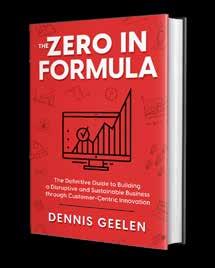
11 minute read
Cover Story
Tending the rural economy
}} Local entrepreneurs say that while they appreciate the city’s support, the needs of businesses outside the towns and villages require special attention
Advertisement
GEOFF COLEMAN Writer-at-large
Although the bigger communities in Kawartha Lakes — Bobcaygeon, Fenelon Falls and Lindsay — are often seen as the focus of the local economy, global ization means that they are unlikely ever to return to the days of large-scale man ufacturing facilities such as Fleetwood or Viskase. Economic development now means nurturing smaller operations, many of them located outside our popu lation centres. That in turn means thinking differently about how to support these rural businesses.
Rebecca Mustard, the city’s economic development manager, says that while her department still works to attract big companies, supporting small, existing business is at least as important as what she calls “smokestack-chasing.”
She’s referring to the old way of thinking about economic development. The cautionary example is the town of Racine, Wisconsin, which has a popu lation comparable to that of Kawartha Lakes. In 2017, Racine persuaded Taiwan ese manufacturing giant Foxconn — best known for making iPhones and other Apple devices — to build a factory there. The state’s governor came up with a subsidy and tax-break package total ling almost $3 billion U.S. to attract the company, but Foxconn didn’t live up to the original terms of the agreement. Instead, it built a smaller factory that used robotic assembly lines, ultimately creating far fewer jobs than promised.
Wooing a major company is not the only road to jobs and prosperity. Though
REBECCA MUSTARD Manager of Economic Development for Kawartha Lakes
less glamorous, supporting smaller businesses already firmly rooted in the local community and looking to expand can produce significant dividends. Those companies are also much less likely to leave town for a better offer.
Economists say that 70 per cent of new jobs come from existing businesses. Helping them and encouraging local people looking to start an enterprise — something known as “economic garden ing” — is a big focus of Kawartha Lakes’ economic development department.
Mustard points out that there are all kinds of people who want to start their own business. “And that’s great. We want to help provide them with a foundation that ensures they will start strong and remain viable.”
Her department runs programs like Summer Company and Starter Company Plus, providing seed money and advice for young people and new business own ers of any age who are taking their first stab at entrepreneurship.
Mark Imrie of the Imrie Group, a Woodville-area company offering haul age, excavation, septic and landscaping services, is a graduate of both programs. He found the pairings with two mentors arranged by the economic development department to be particularly useful. “I got a great variety of information. We had monthly meetings and I got really good advice on running a business, marketing, and setting up a website.”
Quaker Oaks Farm. Photo: Roderick Benns.
THE RURAL ECONOMY
CONT’D FROM PAGE 13
Dan Kitchen owns Make Stuff Move, located near Argyle. The company creates sets of real tools and motors for use in STEAM (science, technology, engineering, arts and math) education. The economic development department helped him with “getting the background stuff in place” to co-host an event called Invent Make Play with local non-profit Pinnquaq Association.
“They just in general seem to have an open-door policy and are always willing to share info to help grow businesses,” says Kitchen.
Not everyone has had a similarly positive experience though. One business owner in the northern part of Kawartha Lakes says she is disappointed that more isn’t being done for rural areas, such as “cutting development fees, streamlining building permits, or promoting skilled trades to improve the local labour force.” (The Advocate has withheld her name upon request due to her position in the community.)
Besides its programs for entrepreneurs, Mustard also points to the Arts and Heritage Trail as an example of economic development in rural areas. The trail was launched in 2017 to enhance awareness of the city’s heritage and the wide variety of museums, historic sites, artist’s studios and galleries located in Kawartha Lakes.
ONLINE INEQUITY
Much of the training the economic development department provides is only available online, meaning it is not equally available to all. Even before the COVID-19 outbreak, the department’s offerings for local entre preneurs were heavily focused on webinars and other internet-based training sessions. For businesses located where high-speed internet is unavailable, though, such opportunities are completely inaccessible.
Mark and Judy Spurr own Quaker Oaks Farm near Sebright and are participants in the Arts and Heritage Trail. They say they’ve been told flat out by Bell Canada that economies of scale ensure they will never have highspeed service where they live, so the city’s online pro grams are out of their reach. Similar scenarios play out all over Kawartha Lakes, and even businesses that pay for high-speed access may not be any further ahead.
As reported in the July Advocate, the Canadian Radiotelevision and Telecommunications Commission has identified a speed of 50 mbps upload and 10 Mbps download with unlimited data — often shortened to 50/10 — as the minimum for individuals and businesses to be able to take full advantage of critical online functions such as stream ing high-definition video and using cloud-based software and storage. CONT’D ON PAGE 16


Women’s Resources of Kawartha Lakes CASH PLUS RAFFLE!
1ST PRIZE: $5,000 CASH
2ND PRIZE: $1,000 CASH 3 RD PRIZE: HP CHROMEBOOK, VALUE $400
DONATED BY MicroAge Peterborough/Whitby
Draw Date: February 15, 2021 at Women’s Resources, 22 Russell St. E., Lindsay Tickets: $10 per ticket or 3 for $20 Only 4,500 Tickets Printed!
ON SALE OCTOBER 19 Purchase in Lindsay at: Women’s Resources, 22 Russell St. E.•Vicky’s Values, 50 Mary St. W.
Questions? Contact Carolyn Fox 705-324-7649 ext. 223 or cfox@womensresources.ca 705-878-4285 :: 22 Russell St. E., Lindsay, ON K9V 2A1 :: www.womensresources.ca
Shelter, Support & Refferal for Abused Women and their Children
THE RURAL ECONOMY
CONT’D FROM PAGE 15
One business owner in the northern part of the city says he can only dream of such service, pointing to wildly varying upload and download speeds at his rural location. Just one company provides internet service where he lives. While he finds his speeds at 2 a.m. are acceptable (occa sionally reading 10 megabytes per second), during the day they are routinely around 1 to 2 mbps.
He sees the same thing every day after supper as people turn to video streaming for their evening’s entertainment. “My service degrades to virtually unusable … like .1 to .5 mbps, and we are frequently disconnected from the tower. This makes streaming or video-conferencing an impossibility, and even basic browsing a challenge. A speed of .1 mbps is 1 kilobyte per second … or about the speed of the dial-up modem I was using 25 years ago.”
Such poor service is a major barrier for rural businesses. In fact, this particular entrepreneur was so concerned that he would actually lose business if people were to know the challenges he faces in something as basic as completing the timely electronic transfer of documents, that the Advocate agreed not to identify him or his company.
Rural business owners may see some light at the end of the tunnel, however; the city has thrown its support behind an initiative to bring faster internet to the city in co-operation with the Eastern Ontario Regional Network (EORN). It is seeking federal and provincial support to deliver ultra-fast internet to homes and businesses in the region through a $1.6 billion public-private partnership.
“This would be a game-changer for eastern Ontario to attract and retain businesses and residents, and to compete globally over the long term,” said Kawartha Lakes mayor, Andy Letham, who chairs the Eastern Ontario Wardens’ Caucus.
A reliable, affordable high-speed network is as essential as a transportation network, business owners say. Combined with a clearer focus on the needs of the rural businesses that are the most likely to provide more local jobs through expansion, it will create a climate that ensures these smaller players can thrive without having to leave Kawartha Lakes.
What does Rural Economic Development look like to you and how does it affect your insurance needs:
How lucky are we to live in a rural community surrounded by working farms, supported by many Agri-Businesses and even some Co-operatives. At SMI we know that Farms and Agri-Businesses are the core of our business and our community and the products produced are food for our future. At SMI we want to be an active partner for your Farm, Agri-Business or Co-op to ensure you have the right coverage tailored to your operation. You may be cash cropping, a full livestock operation or you may have added a tourism piece to your business to encourage people to come to our area and experience what it means to live in the country! Maybe you our an equipment dealer or supplier to our local farmers. Whatever you do in Agriculture and Economic Development in our rural area, we have the coverage for you. Before you renew again, contact one of our experts to see what a ‘working’ insurance broker with strong rural roots can do for you, one that under stands your business, whatever it is as we are your neighbour.
More news and stories available at

lindsayadvocate.ca
CONNECT WITH YOUR SMI FARM SPECIALIST

PHONE


VIDEO EMAIL

MOBILE APP COMING SOON!
FOR ALL YOUR INSURANCE NEEDS
FARM | HOME | AUTO | BUSINESS
STEWARTMORRISON.CA 705.324.6681 | 1.800.811.5841
advertorial
The Cat & Fiddle Lindsay chef offers up traditional pub fare and delicious Caribbean cuisine

On any given day, the kitchen at The Cat & The Fiddle Wray’s boss, The Cat’s owner Lisa Miller, says she Lindsay, like any restaurant, is a cacophony of sound. was drawn to Wray’s confident, composed demeanour as The clanging of pots and pans and cutlery, the sizzle much as his “level and degree of professionalism” when from a grill or fryer, the steady swish of a two-way door she recruited him. to the dining area in a constant back-and-forth motion. “He was quiet, and you could tell he was humble,”
And yet, surrounded by that relentless din in the says Miller, a veteran of the restaurant industry who’s restaurant’s hub, Junior Wray finds peaceful solace. owned The Cat for almost 15 years. “No matter what’s happening outThat comfort level also fostered side, or what problems there are,” confidence when introducing newer, says Wray, head chef at The Cat, more exotic dishes to a small-town as it’s known to locals, “once I walk clientele more accustomed to stanthrough that kitchen door, everydard pub fare. Says Miller, with a thing stops ... because I’m in my slight laugh, “Junior was putting out comfort zone.” some pretty wild specials at the
For Wray, who’s 36 but looks start.” 10 years younger, his easy-going, But they persevered, confident take-it-as-it-comes chef’s approach that local taste could extend beyond is as much nature as it is nurture. meat and potatoes — though, Wray Cooking, he says, has “always been says some of the early new offerings a part of me.” he introduced were, strategically,
He also recognized that his Chef Junior Wray at The Cat and The Fiddle Lindsay. made of meat and potatoes. There innate skill needed to be nurtured. Photo: Sienna Frost. was, to be sure, an easing-in period Wray’s training earned him Red for the added menu items, many of Seal Chef status — an accreditation that recognizes his them inspired by his own Jamaican heritage and culinary advanced skills anywhere in Canada. training. He met the challenge by introducing free, small
Wray moved here from Jamaica about 10 years appetizers and educating servers so that they could pasago and fell in love with Lindsay’s small-town charm. sionately describe the food and their unique preparation He reminisces about his childhood when he would to customers. play chef outside the family home, building small fires So while the restaurant has remained loyal to pub stalto transform leftovers. His grandmother, he says, soon warts like fish and chips and wings to burgers and bangers discovered a sure-fire way to console him as a baby and mash — and so much more — there’s no doubt its when he fussed or cried — bring him into the kitchen. Caribbean, such as jerk chicken, roti chicken and curry
One sound you won’t hear in Wray’s kitchen is that are now sharing that spotlight. There’s no denying the of a chef screaming out orders — and insults — to hand he played in the evolution of our area’s taste palate. others in the kitchen. He has worked under such bullyBut Wray is hesitant to shine that spotlight on himself. like mentors. “I know what it feels like when someone “There’s no one person who can do it all,” explains comes in and shouts at you like that.” It’s a trait that Wray. “You need people around you to help. If I put some not only didn’t suit his personality, but one that Wray food out and it’s great, it’s not just me alone; it’s a team. realized early on is counterproductive. You have to have that team.”









